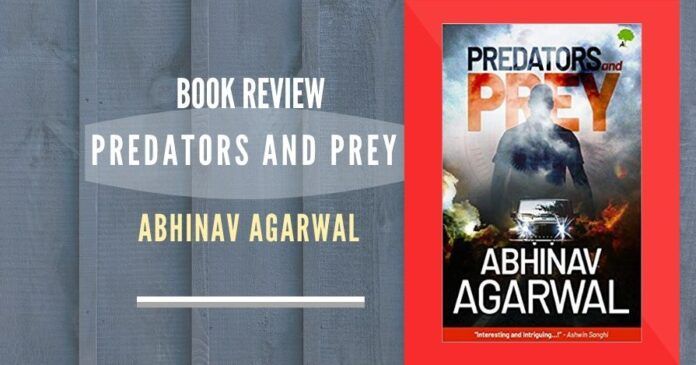
First-time novelist to dare experiment like this is commendable – kudos to Abhinav Agarwal. Novels thrive in their third-person narration to gain their classical and epic orientation.
Predators and Prey by Abhinav Agarwal has both a James Bond-ish novel and a contemporary one in it[1]. Its substance primarily belongs to these eras. Not just because it is on data that is stolen but the way the aftermath plays out. The main villain is a character that was impossible in the past. It is fundamentally the result of individuals, countries, and societies being in the information era. It is James Bond-ish in the vulnerabilities it portrays, international sense of the spread of the plot and the grand assurance of a good closure eventually. However, the assurance of a happy end does not concern because at each step villains posed exciting challenges and there is art, style, and effectiveness with which the protagonists meet them.
But the novel is certainly beyond that. Where it differs from a typical thriller is that – it is not pegged on a singular hero. There are, at least, two. That is a remarkable novelty in the novel. This is, certainly, Indian experiences and sensibilities. Of course, one should not look into characters in the present times for validation of this – we may still get some in it. It is the nature of the portrayal that makes it uniquely Indian. The greater success of the novel is, at times, the way it grows from being a thriller to portraying how the normal lives of people play out in extraordinary circumstances. When the character of time and context becomes a character of many times – even in a few paragraphs – one knows the work is successful. There are memorable moments in the novel when characters take an abnormal journey into their own selves in these trying situations throwing artistic insight to readers. Both the predators and the prey often get portrayed at these levels in the novel, which is a success for a first-time novelist.
When prominent characters speak and act, their persona, context, intentions, and failings come through in a worldly fashion. All the prominent characters and some short-lived ones are well etched.
I will not dwell on the storyline beyond a point. But certain leaves from the novel are worth a pluck. Escaping from their predators the three hunted are on a run and end up encountering a local goon. The goon, upon finding a lady among them, transforms into a predator of a different kind and concocts an ideological safeguard for a carnal attack. At that moment the novel simply grows beyond being a thriller throwing insight into characters. In yet another place, the lady slaps the man who is been sent to save her in order to extract a truth that she thinks is valuable, without worrying about consequences. She presents an immense moral confidence in her act. The man almost behaves like he was in anticipation and is sympathetic to her concern. The characters of a thriller grow into themselves beyond the situation throwing deeper insight, which is not a possibility in a typical James Bond-ish novel. It is not to say that the novel is throughout on this plane. Every time it reaches the plateau of a typical thriller, a portrayal such as this elevates it.
In the form, too, the novel has an interesting Patten. It is largely a conversational novel and, in that sense, close to a movie. But in a 350-page novel heavy in conversation, it is not easy to portray all characters, complex situations, modern technology intricacies in a very realist fashion and realistic detail. It certainly is a success although time alone will tell the extent of it. For a first-time novelist to dare experiment like this is commendable – kudos to Abhinav Agarwal. Novels thrive on third-person narration to gain their classical and epic orientation. Novel though becomes classics in their conversations by excessively indulging in the rhetoric and metaphor. A thriller does not have this luxury. Nevertheless, as it enters the middle of the grand escape, the novel gives the experience of a human situation achieving it in both the conversations and narration.
Beyond this, the strength of the novel is its contemporary-ness in terms of the problem at hand. The novel holds itself with immense grip and excitement. The depth and the detail with which the problem and the conflict play are both entertaining and educating. The intricate detail makes it very realistic. When prominent characters speak and act, their persona, context, intentions, and failings come through in a worldly fashion. All the prominent characters and some short-lived ones are well etched.
Lastly, throughout the novel, one flank that hits the reader is that the prey does not understand who is behind them while they are on the run. Some predators simply do now know that they are being preyed upon as well. So much of a metaphor for the complexity of our times. A novel that achieves this is nothing but a success. Welcome, Abhinav Agarwal – the novelist.
Note:
1. The views expressed here are those of the author and do not necessarily represent or reflect the views of PGurus.
References:
[1] Predators and Prey – Amazon.in
- Book Review: ‘Predators and Prey’ by Abhinav Agarwal - March 5, 2020










